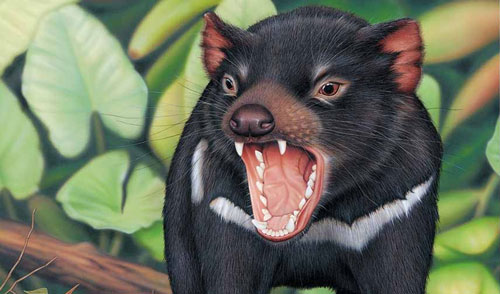“Devilish” Riversleigh Marsupial Hyena from Queensland
Scientists including researchers from the University of New South Wales, have named a new species of carnivorous marsupial that would have terrorised Australia’s ancient forests some five million years ago.
The animal would have been roughly the size of a Labrador dog, but closely related to the extant Tasmanian Devil (Sarcophilus harrisii). The Tasmanian Devil, with its powerful jaws, has a formidable reputation but this newly described meat-eating marsupial would have been two and half times the size of its modern relative.
An Illustration of the New “Devilish” Ancient Marsupial
Picture credit: University of New South Wales/Phil McKay
Whollydooleya tomnpatrichorum
Named Whollydooleya tomnpatrichorum, it is the first creature to be formally identified from a remote fossil site located in north-western Queensland that has only recently been mapped.
W. tomnpatrichorum may have been an apex predator, or perhaps it filled the role of a hyena-like animal, hunting but also scavenging the kills of other predators. Scientists who have studied the single molar tooth, from which the species has been erected, suggest that Whollydooleya could have weighed as much as twenty-five kilogrammes.
Lead author of the scientific paper, published in the Memoirs of Museum Victoria, Professor Mike Archer (University of New South Wales), commented:
“W. tomnpatrichorum had very powerful teeth capable of killing and slicing up the largest animals of its day. The Late Miocene between twelve and five million years ago, when Australia began to dry out and megafauna began to evolve, is one of the least understood in the vast continent’s past.”
Whollydooleya tomnpatrichorum Size Comparison (Thylacine and Sarcophilus harrisii)
Picture credit: University of New South Wales
Rare Late Miocene Evidence
Fossils of terrestrial animals from Upper Miocene deposits of Australia are extremely rare, however, the remarkable outcrops located at Riversleigh in north-western Queensland hold the record for the density of fossil finds. In 1983, a study of two cubic metres of rock from the Riversleigh site yielded an astonishing fifty-eight new species of prehistoric mammal. The location from where the single tooth (a lower jaw molar), comes from is located outside the Riversleigh World Heritage site, but researchers are confident that this new site will yield a number of new prehistoric marsupial discoveries.
Two Views of the Prehistoric Tooth

Identified from a single tooth Whollydooleya tomnpatrichorum. Stereo views of the single tooth (buccal view – viewed from the cheek side).
Picture credit: University of New South Wales
The new, highly fossiliferous site was found in 2012, thanks to aerial support from a local helicopter company that enabled field team members to cover large tracts of the remote outback. The tooth, was found a year later, it represents the earliest fossil evidence yet of a “Tasmanian Devil-like” animal.
Professor Archer added:
“New Riversleigh is producing the remains of a bevy of strange new small to medium-sized creatures, with Whollydooleya tomnpatrichorum, the first one to be described.”
The Wholly Dooley Site
The genus name refers to the Wholly Dooley site, which was discovered and named by Phil Creaser following analysis of satellite data and Google Earth images. The trivial name honours husband and wife Tom and Pat Rich, both vertebrate palaeontologists who have contributed significantly to the research into ancient marsupials of Australia.








Leave A Comment